Bali Diving: Discover the Beauty of the Ocean in Bali, Indonesia
Bali and its neighboring islands are also renowned for their vibrant nightlife, delicious cuisine, and luxurious resorts, making it a popular vacation spot for tourists from all over the world in Indonesia. Whether you’re looking for adventure or relaxation, Bali and its surrounding islands offer something for everyone. From surfing to hiking to exploring ancient temples, there are endless activities to keep you entertained during your stay in Indonesia.
If you’re feeling more adventurous, why not dive into Bali’s crystal clear waters and discover the breathtaking underwater world in Indonesia? The island is home to some of the best dive sites in the world, with an abundance of colorful marine ecosystems and exotic aquatic life to explore. With experienced instructors and well-equipped diving centers, Bali offers a safe and exciting diving experience for both beginners and advanced divers. So take advantage of the opportunity to take the plunge and explore Bali from a different perspective! Come and discover the magic of Bali and all it has to offer!

Contents
What makes Bali diving so special?
Regarding scuba diving, Bali is a destination that should be noticed. With its open water, beautiful coral reefs, and diverse tropical marine life, the island offers a unique opportunity to explore the underwater world. Bali is also known for its Manta Rays and shipwrecks, making it a popular choice for experienced divers looking for a new challenge. Whether you’re a seasoned pro or a beginner, scuba diving in Bali is an experience you will remember.
The friendly underwater conditions make Bali diving suitable for learning diving with the PADI courses or Try Diving for the first time.
Advanced divers can enjoy diving deep with the Mola Mola during the season of June to October, drift diving with Nusa Penida, or for those passionate about macro photography on the north or east coast of the island.
Bali diving offers a unique cultural experience as well. The island’s rich culture is reflected in the Balinese Hindu temples and traditional fishing villages that can be explored during surface intervals. Balinese hospitality and warmth can also be experienced while staying in a dive resort or homestay, making it an immersive experience for divers. Bali’s diverse aquatic life, including vibrant marine ecosystems, colorful fish, and even the occasional sighting of other large ray species, make it a world-class diving destination. Whether you are a beginner or an experienced diver, Bali diving offers something for everyone.
Here are the top dive sites for Bali Diving
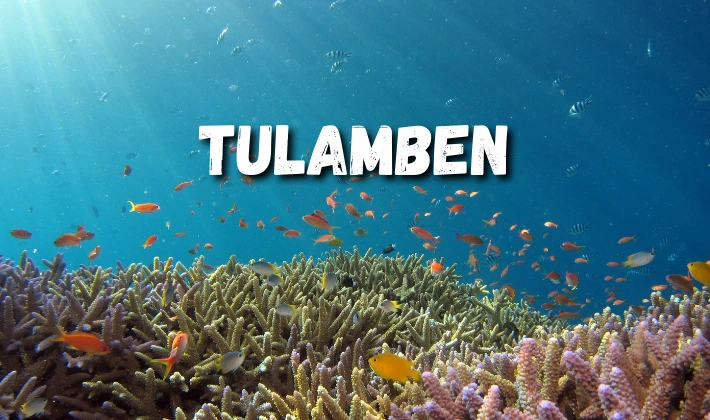
1. Tulamben
Tulamben is one of the world-famous dive sites on the east coast of Bali. It is famous for the USAT Liberty wreck, which has become an artificial reef home to an array of marine life.
Tulamben is also one of the best central Bali diving locations for macro photography, providing opportunities to dive and explore the stunning underwater world. Critters as small as half the size of a rice grain can be found here, making – it a perfect spot for those who love to dive and capture the beauty of marine life through their lenses. We can mention Shawn the Sheep and the amazing Butterfly Nudibranch as some of Tulamben’s most sought-after subjects for macro photography.
Water temperatures in Tulamben, likewise for Amed, are high all year round at approximately 28-29 C / 82 – 84 F.
If you’re looking for the best scuba diving in Bali, in Tulamben, you can dive with the famous USAT Liberty shipwreck. This World War II shipwreck is now home to an incredible array of aquatic life, including schools of fish, octopus, and even reef sharks. Diving with the USAT Liberty wreck is a must-do for any experienced diver visiting Tulamben. With clear visibility and calm currents, the USAT Liberty shipwreck offers a safe and exhilarating dive experience suitable for divers of all levels. So if you’re a diving enthusiast looking for a memorable adventure and the best scuba diving in Bali, consider adding the USAT Liberty shipwreck to your bucket list.
Tulamben is a popular tourist destination in Bali, Indonesia, known for its beautiful beaches, diving spots, and stunning marine life. Here are five things you can do in Tulamben:
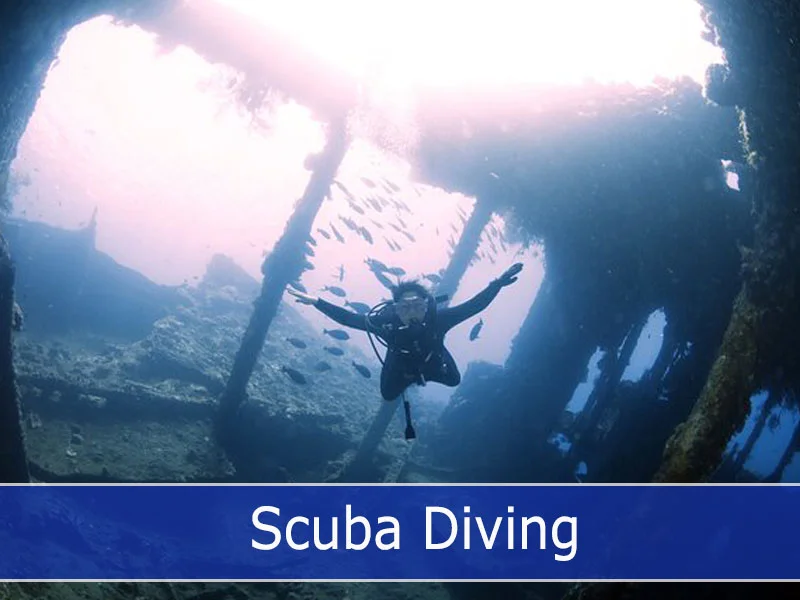
1. Scuba Diving
Tulamben is famous for its shipwreck diving spots, including the USAT Liberty Shipwreck and the Boga Wreck. These wrecks are home to abundant marine life, including colorful fish, turtles, and even sharks. Scuba diving is a popular activity among tourists who visit Tulamben.
Tulamben also boasts vibrant coral gardens and unique underwater volcanic formations, making it a true diving paradise. The area’s nutrient-rich waters attract a wide variety of marine species, providing divers with an unforgettable underwater experience. With excellent visibility and relatively calm waters, Tulamben caters to divers of all skill levels, from beginners to experienced enthusiasts. The warm, friendly local dive community is always eager to share its knowledge and expertise, ensuring every visitor has a safe and enjoyable dive adventure in this spectacular underwater world.
2. Snorkeling
If you need to become a certified diver, you can still enjoy the beautiful underwater scenery in Tulamben by snorkeling. The reefs near the shore are home to a variety of marine life, including vibrant coral and schools of fish.
Snorkeling in Tulamben offers an easily accessible and affordable way to explore the underwater wonders of the region. The shallow waters along the coast provide excellent opportunities for beginners and families to experience the thrill of observing marine life up close. From playful clownfish darting among the anemones to majestic sea turtles gliding through the water, snorkelers are sure to be mesmerized by the diverse aquatic ecosystem. Local tour operators offer guided snorkeling excursions, ensuring that even first-time snorkelers can safely discover the breathtaking beauty beneath Tulamben’s crystal-clear waters.

3. Beach Hopping
Tulamben has several beautiful beaches, including Tulamben Beach, Sambang Beach, and Kubu Beach. Spend a day beach hopping and enjoy the sun, sand, and sea.
Beach hopping in Tulamben is a fantastic way to experience the diverse coastline and immerse yourself in the laid-back, tropical atmosphere of this enchanting region. Each beach has its unique charm, with varying landscapes that range from black volcanic sand to pristine white shores. Relax under the shade of swaying palm trees, take a refreshing dip in the clear blue waters, or indulge in local Balinese cuisine at one of the many beachfront cafes and restaurants. The picturesque sunsets, friendly locals, and serene ambiance create an idyllic setting for a memorable and rejuvenating beach-hopping experience that will leave you longing to return to Tulamben’s sun-kissed shores.
4. Visit Pura Lempuyang Temple
Pura Lempuyang Temple is a beautiful temple complex located on the slopes of Mount Lempuyang. The temple is famous for its stunning views of Mount Agung and is considered one of the most beautiful temples in Bali.
A visit to Pura Lempuyang Temple offers breathtaking views and a unique spiritual journey. As one of Bali’s oldest and most revered temples, it is part of the island’s “kayangan jagat,” or sacred temple network. The complex comprises seven temples, each connected by a series of steps, inviting visitors to embark on a contemplative pilgrimage as they ascend through the lush Balinese landscape. The iconic “Gateway to Heaven” at the temple’s summit provides a captivating photo opportunity, framing the majestic Mount Agung in the distance. With its rich cultural and historical significance, Pura Lempuyang Temple is an essential destination for anyone seeking to delve deeper into Bali’s spiritual and natural beauty.
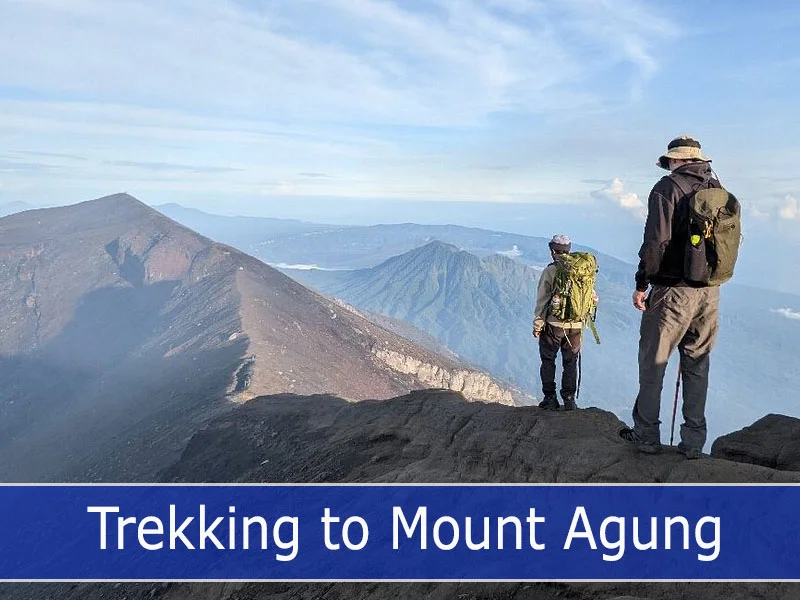
5. Trekking
If you’re feeling adventurous, you can trek in the surrounding hills and mountains. The trek to Mount Agung is top-rated among tourists, as it offers stunning views of the sunrise over the island.
Embarking on a trekking adventure in Tulamben and its surrounding areas allows you to experience the region’s natural beauty up close and personal. The challenging yet rewarding trek to Mount Agung, Bali’s highest and most sacred peak, is a must for outdoor enthusiasts. Along the way, you’ll traverse through dense forests, picturesque rice terraces, and traditional villages, offering glimpses into the island’s unique culture and daily life. The ascent to the summit, ideally timed to witness the awe-inspiring sunrise, reveals panoramic vistas of Bali’s lush landscape and the neighboring islands. Guided treks led by experienced local guides ensure a safe and enjoyable experience, allowing you to fully appreciate the wonders of Tulamben’s pristine and diverse environment.
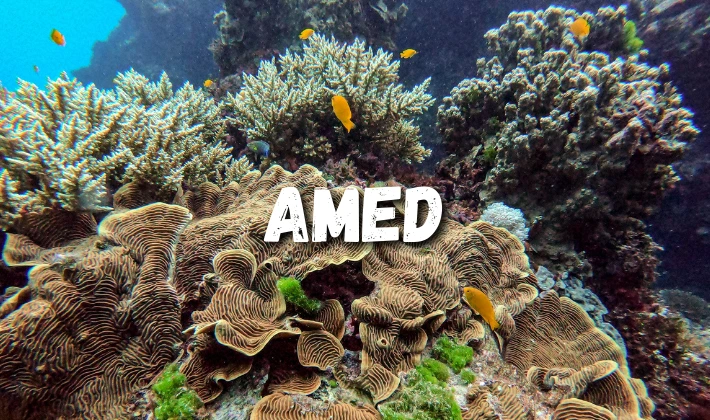
2. Amed
Amed is a small fishing village located on the northeast coast of Bali, a neighbor of Tulamben. As diving activities have developed in the area, the village has been transformed into a diver’s paradise. Amed features a volcanic black sand beach with clear and rich waters, making it an ideal location for snorkeling and diving.
Black Tip Reef Sharks can often be seen here, but Amed provides both artificial and natural dive sites filled with diverse tropical aquatic life.
The calm and tranquil atmosphere in Amed is perfect for those looking to escape the hustle and bustle of busy tourist areas in Bali. The village is home to a tight-knit community with friendly locals who are always happy to welcome visitors and share their traditional way of life. Visitors can waste their time enjoying delicious local cuisine, exploring traditional markets, or participating in cultural ceremonies and events. Amed is also a popular spot for yoga and meditation retreats, with its beautiful natural scenery and peaceful ambiance providing the perfect setting for relaxation and mindfulness. Whether you’re a seasoned diver or simply looking for a serene getaway, Amed is a must-visit destination in Bali.

3. Menjangan Island
Menjangan Island is located northwest of Bali and is part of the West Bali National Park. It offers some of the best diving opportunities in Bali, with its clear waters, rich aquatic life, and vibrant coral reefs maintained very well by controlling the number of divers visiting here.
Diving in Menjangan is best to be done while also staying on the north coast of Bali, as the distance from the south tourist coast can make day trips very long and exhausting. The crystal clear open water surrounding Menjangan Island is also a popular spot for water sports enthusiasts, with opportunities for kayaking, stand-up paddleboarding, and swimming in the calm, inviting waters. Whether you’re seeking adventure or relaxation, Menjangan Island has something for everyone to enjoy in its beautiful open water setting.
Aside from diving, Menjangan Island also offers other activities, such as snorkeling, hiking, and wildlife spotting. Visitors can also enjoy a relaxing time on the island’s beautiful beaches while taking in the stunning views of the surrounding scenery. Menjangan Island is a perfect destination for those seeking a serene escape from the hustle and bustle of Bali’s crowded tourist areas. With its unique natural beauty and diverse marine life, Menjangan Island is worth – a visit for any nature lover or adventure seeker traveling to Bali.
One of the main attractions on Menjangan Island is the West Bali National Park, where visitors can experience the island’s diverse wildlife and natural beauty. The park is home to many endangered species, such as the Bali Starling and the Javan Rusa deer, making it an important conservation area in Bali. Visitors can also enjoy trekking and hiking in the park’s forests and mangroves, taking in breathtaking views of the surrounding mountains and sea. With its stunning natural scenery and opportunities for adventure, Menjangan Island is a must-visit destination for those looking to experience the best of Bali’s natural beauty.
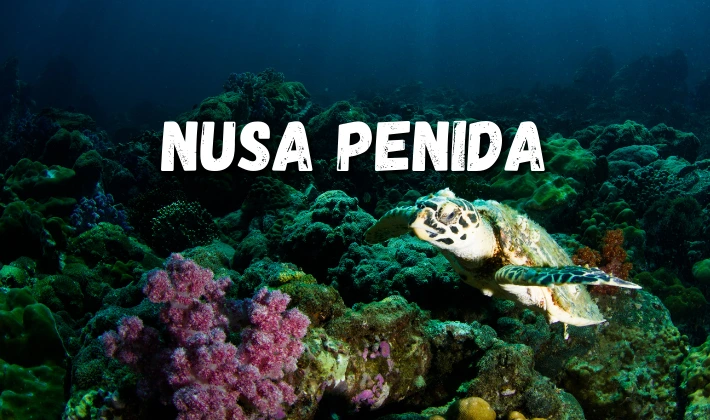
4. Nusa Penida
A small island located off the south coast of Bali. It is known for spotting the Manta Rays at the famous spot Manta Point, at the deep waters and rich aquatic life. During the season of June to October, when the water temperature is low, divers can spot the elusive Sun Fish, also known as Mola Mola.
Water temperatures here during June – October can be as low as 16 C / 60 F
To enjoy it to the fullest, you will ideally need to do three dives here. The 3rd dive site is generally on the island’s north side, where the coral reefs are the best of what Bali diving can provide.
Diving, as well as exploring the stunning underwater world, is one of the best experiences like no other. With its vibrant coral reefs, diverse aquatic life, and strong currents, it’s a destination that offers something for every diving enthusiast. Whether you’re interested in drift diving, underwater photography, or simply observing the colorful tropical fish and sea turtles, It’s the perfect location to indulge your passion for diving and immerse yourself in the beauty of Bali’s underwater world. So pack your diving gear and get ready to discover the wonders that await you!
A beautiful island off the southeast coast of Bali, Indonesia. Here are five things to do in Nusa Penida:
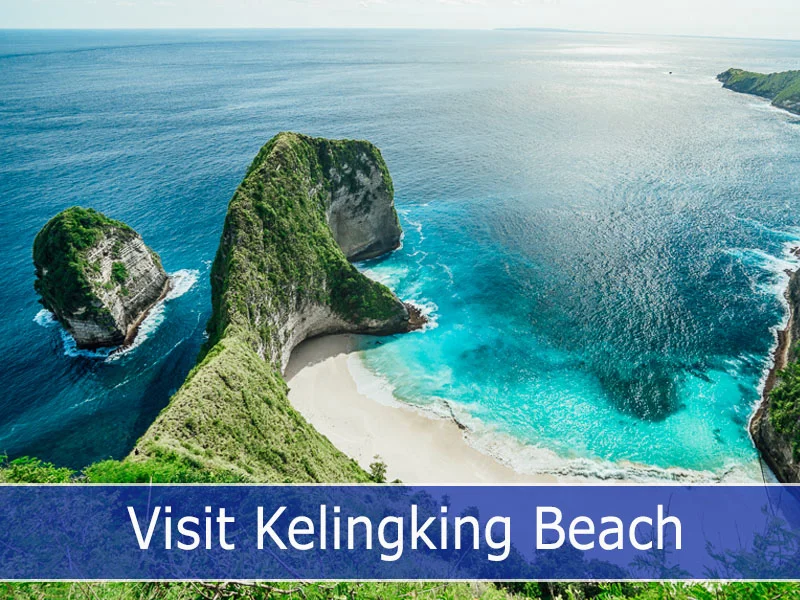
1. Visit Kelingking Beach
Kelingking Beach is one of the most famous spots. The view from the top is breathtaking, and the beach below is stunning, with turquoise waters and white sand. The hike down to the beach is challenging but worth it.
Visitors can swim in the crystal-clear waters or relax on the pristine beach. Snorkeling is also a popular activity at Kelingking Beach, with plenty of colorful marine life to observe. Additionally, there are a few small warungs (local food stalls) where visitors can purchase refreshments and snacks. Kelingking Beach is a must-visit destination for anyone traveling to Nusa Penida, offering a truly unforgettable experience amidst the stunning natural beauty of Indonesia.
2. Snorkeling or diving
Known for its crystal-clear waters and abundant marine life. There are many snorkeling and diving spots around the island, such as Crystal Bay and Manta Point, where you can swim with manta rays and see colorful coral reefs.
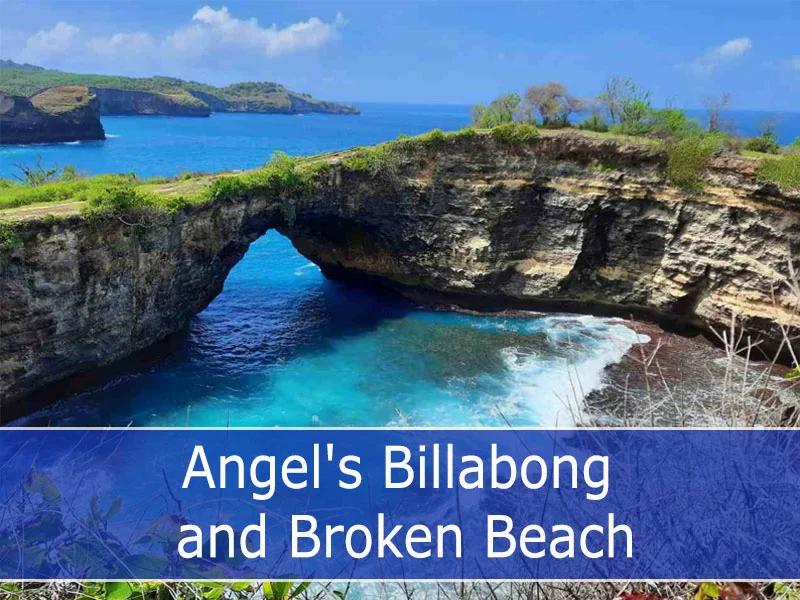
3. Angel’s Billabong and Broken Beach
These two natural wonders are located near each other and are a must-visit in Nusa Penida. Angel’s Billabong is a natural infinity pool, while Broken Beach is a natural arch that the ocean has eroded over time.
4. Explore Atuh Beach
Atuh Beach is a secluded beach located on the eastern side of Nusa Penida. It is known for its stunning cliffs, clear waters, and white sand. The beach is perfect for swimming, relaxing, and enjoying the beautiful scenery.
5. Watch the sunset at Thousand Island Viewpoint
The Thousand Island Viewpoint offers a panoramic view of the ocean and the small islands. It’s the perfect spot to watch the sunset and take in the beautiful colors of the sky.

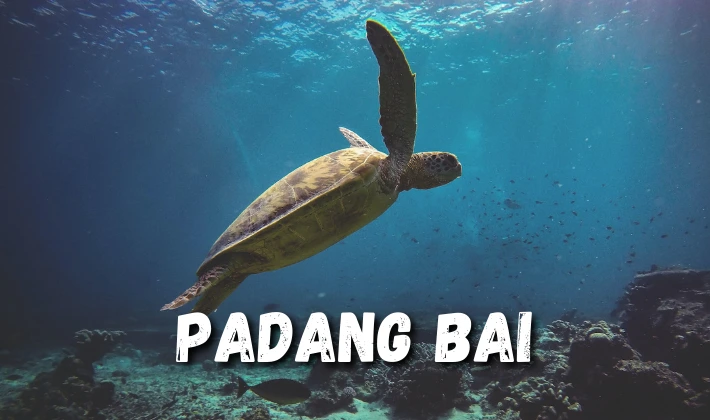
5. Padang Bai
Padang Bai is the ideal location for a leisurely day of underwater exploration as it’s easily reachable with a short car trip, and the conditions are proper for beginners with generally low to no currents.
From June to October, water temperatures in Padang Bai drop to approximately 24-26 C / 75 – 78 F.
You will need an advanced certification and at least 50 dives at Gili Mimpang and Tepekong, as currents here are extreme. But if you are an experienced diver, you will have the opportunity to spot sharks and, during the right season, with the Mola Mola, making it a great diving destination.
Padang Bai also offers other exciting activities. Visitors can explore the small town and its traditional markets, take a scenic hike through the lush forest to the top of the hill to catch a panoramic view of the bay, or hop on a boat for a short ride to the nearby islands for a day of snorkeling, sunbathing, as well as beach-combing. Additionally, Padang Bai is a vital transportation hub connecting Bali to the neighboring islands of Lombok and Nusa Penida. From here, visitors can catch a ferry or a speedboat to experience the unique cultures and natural beauty of these islands. With its stunning underwater world, charming town, and convenient location, Padang Bai is a must-visit destination for anyone seeking an authentic Bali experience.
When is the best time to visit Bali for diving
The diving conditions in Bali are generally good all year round, with warm waters and good visibility even in the wet season.
If your travel plans allow, you will find that the best time to visit Bali for diving is from May to October. During this period, the dry season brings about the best open-water conditions for diving. However, you will also notice that water temperatures drop in Nusa Penida and Padang Bai during this time, so it’s highly recommended that you bring a 5mm wetsuit.
Bali offers some of the best scuba diving experiences in the world, with its stunning underwater landscapes, vibrant marine ecosystems, and diverse aquatic life. During the dry season, an ideal time for a diving experience in Bali, you’ll be able to witness the full glory of its underwater world, including the best scuba diving experience in Bali. The water temperature is comfortable, and the sea is usually calm, making exploring the breathtaking diving sites easier and having an amazing diving experience.
However, if you prefer quieter dives, consider visiting during the shoulder months of May or October, when the conditions are still good, and you can experience the best scuba diving experience in Bali without the crowds. Overall, Bali is a must-visit destination for divers looking for an unforgettable diving experience, and you won’t regret exploring its underwater wonders.
How to reach the Bali diving spots
Bali is a big island, much bigger than many would think. Traveling to Bali for diving activities requires car transportation and knowledge of the local dive sites, access to these dive sites, etc.
That is why choosing a dive center like ours is the best way to explore Bali diving. We know exactly where to go, when, and how to dive all the dive sites properly. Our extensive knowledge of the Bali weather, underwater conditions, and aquatic life has earned us the five stars reputation.
Even if you choose to explore Bali Diving with us or another dive center, it is the best approach to avoid engaging in diving in Bali alone. Choose a dive center or a dive guide.
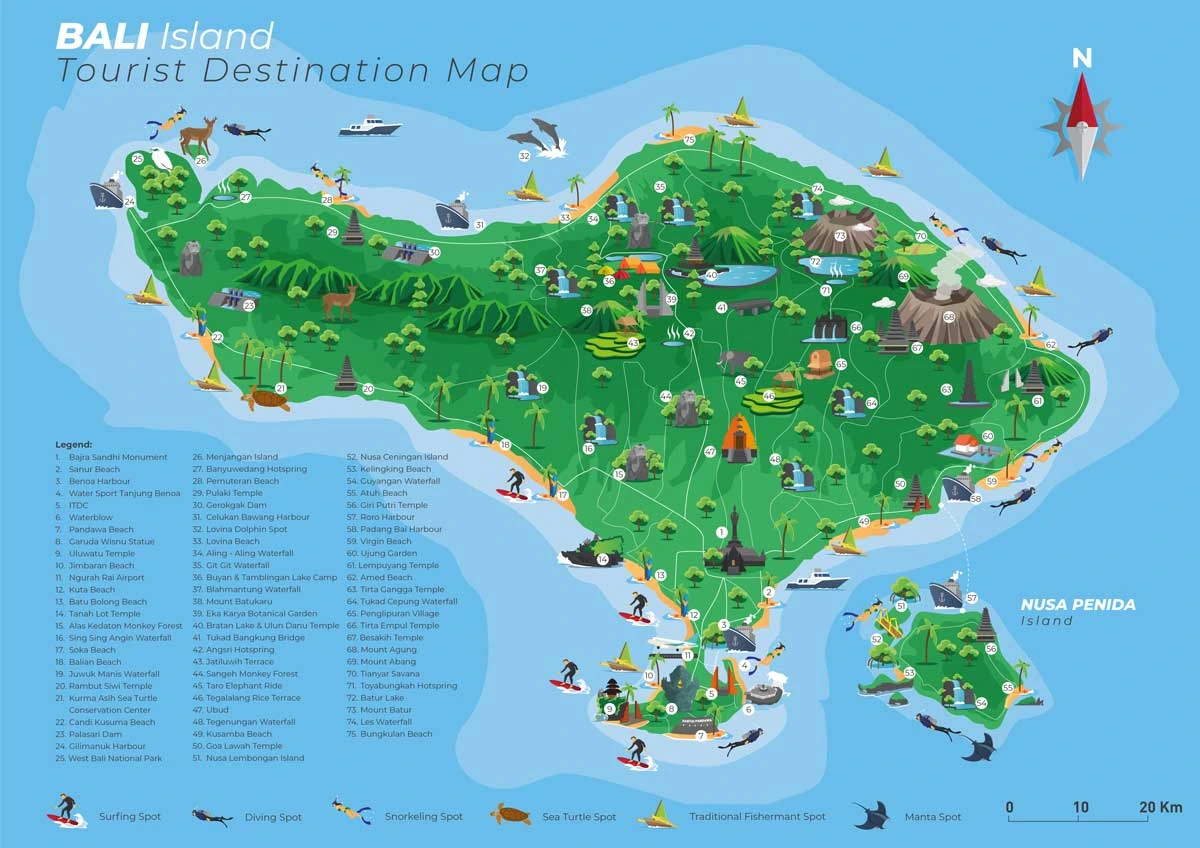
Click image to enlarge
Read more in-depth about the best Bali dive sites and how to choose a Bali dive shop. Please plan accordingly for your upcoming Bali Dive Trips, or you can first read about our Bali Diving Packages.
Bali has an abundance of diving schools scattered all across the island, starting from Sanur and Seminyak in the south and west to Padang Bai, Tulamben, and Amed in the east. We have prepared a detailed guide to where to find the best diving school in Bali.
Frequently Asked Questions about Bali Diving
What makes Bali a popular diving destination?
Bali, located in the Coral Triangle, is renowned for its diverse marine life, vibrant coral reefs, and unique dive sites, including shipwrecks, muck diving spots, and drift dives. The warm, clear waters and rich underwater landscapes make it an attractive destination for divers of all skill levels.
When is the best time to dive in Bali?
Bali offers year-round diving opportunities, but the best conditions generally occur during the dry season, from April to October. During this time, the water visibility is higher and the sea conditions are calmer, making for more enjoyable dives.
What marine life can I expect to see while diving in Bali?
Bali is home to a wealth of marine life, including over 500 coral species, various fish species (such as manta rays, sunfish, moray eels, and lionfish), sea turtles, sharks, and macro critters like nudibranchs and pygmy seahorses. The specific marine life you encounter will depend on the dive site you choose.
What are some of the top dive sites in Bali?
Bali boasts numerous world-class dive sites, including the USAT Liberty Shipwreck in Tulamben, Crystal Bay in Nusa Penida, Manta Point for manta ray sightings, Menjangan Island for its pristine coral walls, and Secret Bay for muck diving enthusiasts.
Do I need to be certified to dive in Bali?
While you need to be certified to dive independently in Bali, many dive centers offer introductory dives and PADI/SSI certification courses for beginners. These courses allow you to experience scuba diving under the supervision of a certified instructor.
What are the requirements for diving in Bali?
To dive in Bali, you must possess a valid scuba diving certification, such as PADI or SSI, and adhere to the depth and safety guidelines outlined by your certification level. Additionally, you should carry dive insurance and follow standard safety practices, such as checking your equipment and diving within your limits.
Can I rent diving equipment in Bali?
Yes, numerous dive centers in Bali offer a full range of scuba equipment rental services. However, it's essential to ensure that the equipment is well-maintained and fits correctly before diving.
Are there any safety concerns or hazards when diving in Bali?
Diving in Bali is generally safe when following standard safety precautions and guidelines. However, be aware of site-specific hazards, such as strong currents or surge, which can vary depending on the location and time of year. It's always a good idea to dive with a reputable dive center and a local guide familiar with the area's conditions.
How do I get to the different dive sites in Bali?
Dive centers in Bali typically offer transportation to and from dive sites, either by car or boat, depending on the location. Some of the more remote dive sites, such as Menjangan Island, may require a longer boat ride.